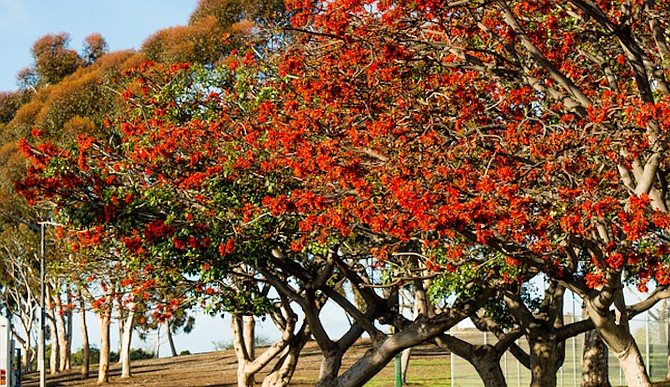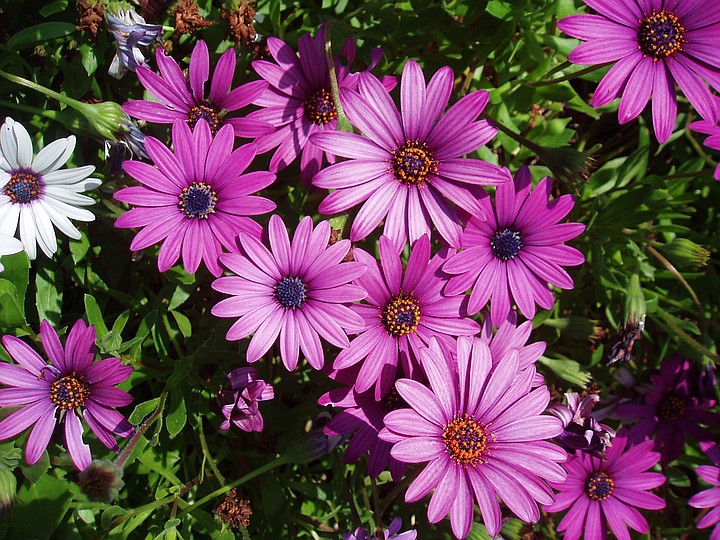 Facebook
Facebook
 X
X
 Instagram
Instagram
 TikTok
TikTok
 Youtube
Youtube

Ocean Water Temperatures, of late in the high 50s Fahrenheit, are finally on the upswing as the daylight hours lengthen and the sun arcs higher overhead in the sky each day. It will take about five months of spring and summer sunshine before the ocean's enormous mass and large heat capacity fully responds to the input of solar energy. A maximum water temperature in the low- to mid-70s is expected by August or September.
March Is the Proverbial Windy Month here in San Diego, as in most places. From midday to late afternoon, sunwarmed air expands and rises over the county’s interior, drawing in an influx of cool air from the coast to replace it. These afternoon sea breezes will continue at peak strength until well into the summer, providing dependable conditions for such sports as sailing, kite flying, and hang-gliding.
Bright green leaves on sycamore, liquidambar, and other decorative deciduous trees around San Diego. Cruise down 163 through Balboa Park to appreciate the vernal splendor of the sycamores growing in the landscaped center divider. Or walk across the El Prado bridge and look down upon the same.
Mexican Coral Trees, or “naked corals,” are showing their stuff this season by bearing flamelike flowers on the tips of their twisting, often leafless branches. Commonly planted as park and freeway landscaping, this and other species of coral are blooming along State Route 94, Interstate 5 through Oceanside, along Harbor Drive near the airport, at the San Diego Zoo, on the lawns in front of San Diego City College downtown, and on the San Diego State University campus. The bloom may continue into late spring, when the naked corals will cover themselves with eight-inch-long leaves, just in time to provide shade for the warm months.

African Daisies are bursting into bloom around San Diego, especially along the freeway embankments. The name refers to a wide variety of species belonging to the genuses Arctotis, Dimorphotheca and Osteospermum, with flowers ranging in color from yellow, orange, and white to purple. These hardy ground covers require little water except when in active growth and help to hold soil in place during heavy rains.
The stars of Canis Major in a moonless dark sky can be connected to form a nice dog profile, but through a brighter sky only his five brightest stars show well. These form the unmistakable Meat Cleaver. Sirius and Murzim (to its right) are the Cleaver's wide top end, with Sirius sparkling on its top back corner. Down to Sirius's lower left is the Cleaver's other end, including its short handle, formed by the triangle of Adhara, Wezen, and Aludra. The Cleaver is chopping toward the lower right.
The above comes from the Outdoors listings in the Reader compiled by Jerry Schad, author of Afoot & Afield in San Diego County. Schad died in 2011. Planet information from SkyandTelescope.org.


Ocean Water Temperatures, of late in the high 50s Fahrenheit, are finally on the upswing as the daylight hours lengthen and the sun arcs higher overhead in the sky each day. It will take about five months of spring and summer sunshine before the ocean's enormous mass and large heat capacity fully responds to the input of solar energy. A maximum water temperature in the low- to mid-70s is expected by August or September.
March Is the Proverbial Windy Month here in San Diego, as in most places. From midday to late afternoon, sunwarmed air expands and rises over the county’s interior, drawing in an influx of cool air from the coast to replace it. These afternoon sea breezes will continue at peak strength until well into the summer, providing dependable conditions for such sports as sailing, kite flying, and hang-gliding.
Bright green leaves on sycamore, liquidambar, and other decorative deciduous trees around San Diego. Cruise down 163 through Balboa Park to appreciate the vernal splendor of the sycamores growing in the landscaped center divider. Or walk across the El Prado bridge and look down upon the same.
Mexican Coral Trees, or “naked corals,” are showing their stuff this season by bearing flamelike flowers on the tips of their twisting, often leafless branches. Commonly planted as park and freeway landscaping, this and other species of coral are blooming along State Route 94, Interstate 5 through Oceanside, along Harbor Drive near the airport, at the San Diego Zoo, on the lawns in front of San Diego City College downtown, and on the San Diego State University campus. The bloom may continue into late spring, when the naked corals will cover themselves with eight-inch-long leaves, just in time to provide shade for the warm months.

African Daisies are bursting into bloom around San Diego, especially along the freeway embankments. The name refers to a wide variety of species belonging to the genuses Arctotis, Dimorphotheca and Osteospermum, with flowers ranging in color from yellow, orange, and white to purple. These hardy ground covers require little water except when in active growth and help to hold soil in place during heavy rains.
The stars of Canis Major in a moonless dark sky can be connected to form a nice dog profile, but through a brighter sky only his five brightest stars show well. These form the unmistakable Meat Cleaver. Sirius and Murzim (to its right) are the Cleaver's wide top end, with Sirius sparkling on its top back corner. Down to Sirius's lower left is the Cleaver's other end, including its short handle, formed by the triangle of Adhara, Wezen, and Aludra. The Cleaver is chopping toward the lower right.
The above comes from the Outdoors listings in the Reader compiled by Jerry Schad, author of Afoot & Afield in San Diego County. Schad died in 2011. Planet information from SkyandTelescope.org.
Comments